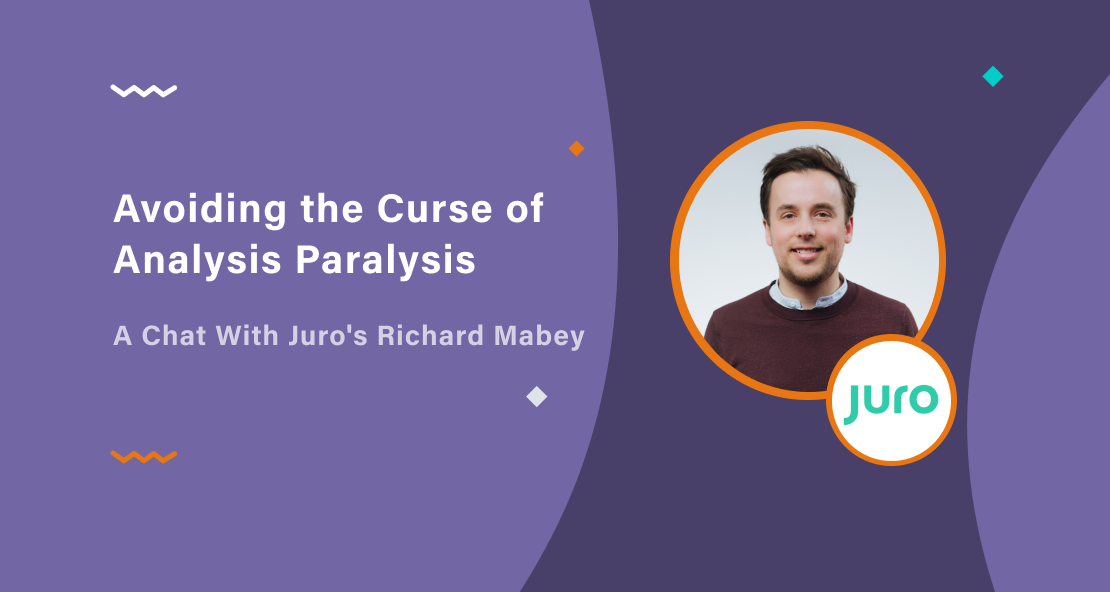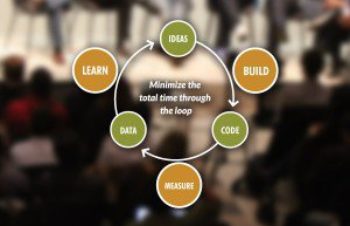Avoiding the Curse of Analysis Paralysis: A Chat with Juro’s Richard Mabey

I’m Richard Mabey, one of the co-founders of Juro and currently CEO of the company. Juro is a contract automation platform – we work with legal and business teams to help them streamline contract workflow in one unified workspace.
Before co-founding Juro, you were a lawyer – was there a moment where the need for this product hit you? Or was it a case of experiencing lots of pain points that proved the product market fit?
It was both. There’s one particular moment I remember where I had to negotiate 50 nondisclosure agreements within five days. I thought to myself ”there must be a better way of doing this than Microsoft Word, emails and desktop storage.”
More generally, the legal profession has known about the problems we face for some time. A daily frustration for me as a lawyer was manually saving files on my desktop and running red lines between them. It’s an unglamorous job that’s low value add – and most lawyers really want to do the complex work that they trained for rather than spend hours doing tasks like this.
So it became a no brainer that automating those routine tasks around contracts would help people and hopefully help the world a little bit.
Juro is not just for lawyers – you’re also used by developers, HR teams and other business areas. Since Juro launched in 2016, how has the product developed?
Hugely! We work with multiple teams – people who deal with contracts are often HR teams, developers, people in partnership teams, sales teams, and then of course, people on the other end of that contract.
One of the hardest things for us has been that so many different people are involved in creating and signing contracts, and you want to provide a really good experience for all of them. It took us a long time to build a product we were proud of, and that worked for everyone.
We’re a SaaS company, so the product is pretty much the only thing we sell. It’s got to add enough value that our customers pay and stick around for, we hope, 10 or 20 years.
It’s interesting to hear you talk about your need to create a SAAS product for multiple clients and multiple audiences. How did you prioritize and balance features when developing from an MVP?
You’ve got to create something which someone can actually use and get some value from. That’s a difficult challenge to navigate.
I think getting that right, and seeking out genuine, meaningful validation for your idea or product, is really important. Everyone makes mistakes on this, and we did too in the early days. A lot of startup founders will say you need to go to talk to your users – but I always wondered how you actually do that in a way that isn’t just having unstructured chats with people? Everyone’s too busy!
Having structured interview processes, and asking people about their specific pain points is ultimately the only thing that will enable you to build a great solution.
Even now we invest very heavily in speaking to our customers. On any given day, I would expect that there are around 10 customer conversations going on. We have hundreds of thousands of contracts and thousands of users, and all of this generates huge amounts of data we can learn from – but nothing quite replaces talking to your users and asking them what they’re struggling with.
Thinking back to your first MVP, did you have the skills to build it in house, or did you outsource?
We actually in-sourced that. We were lucky in that I had a co-founder who came from a technical background – he had done a computer science degree, managed engineering teams and co-founded a startup already. So we were in a very fortunate position.
For us, that’s been a very productive partnership in that Pavel has brought deep product expertise and is effectively CTO of the business, as well as being the Chief Product Officer. I run everything else, and that’s worked quite well.
What would be your advice to founders working in industries they have no prior experience in?
Validate the idea, in the shortest amount of time possible. When we think about validation, we’re thinking about validating the problem. You can get quite far by interviewing and speaking to people in a structured way.
Validating your solution is a little bit harder, and this is where a good MVP strategy comes in. You need to think about how you can build something which will tell you, with sufficient sample size, whether there’s a demand for the product. If you can do this upfront, you’ll save years of wasted time.
I think it’s interesting what you say about speed. What balance should you strike between moving quickly and researching thoroughly?
I do some angel investing, so I speak to founders a fair amount. I see cases where people are stuck in analysis paralysis – they read all the books and talk to all the right people, but they’re too hesitant to act. You’re never going to decide whether or not to stake your life on your idea by piling more time into research.
I think people tend to wait too long. They spend two years thinking about whether they’re going to do something and then at the end of it, they’re still not sure – and two years of your career is a huge amount of time!
So, if you built your MVP again, would you complete that process quicker?
Yes probably – rather than being a five-year journey, I think we could achieve the same thing in two and a half years by focusing on doing more of the right things and not doing any of the things that didn’t matter…but you learn the hard way, don’t you? That’s ultimately what entrepreneurship is about – how quickly you can learn.
You mentioned that in the early days you had a pool of clients waiting for this product before it launched. Were they from your pre-existing legal network?
No. As a company, if your pain point is severe enough and you can’t find a viable alternative solution, you’re willing to tolerate a degree of risk to find something that works. The risk we presented was being an untested startup without a product.
We found our initial customers in a scrappy type of way. Cold outreach, cold calling – we did whatever it took to find that cohort. The goal is to identify this cohort that believes in your vision and give useful feedback. If your product is useful for that group of customers, it’s probably going to have wider appeal.
Do you think customer centricity has been key for retaining customers in the long term?
Absolutely. Our customers expand faster than they churn from Juro. A common pattern we see is one business function implementing Juro and then others in the same business following suit, because we’re low cost, low commitment and add value.
As a SaaS company, we make around 80% of our revenue after year one, so we have a large customer success team. We help customers solve their problems, and then ensure we offer a consistently good product. If you’re actively solving a major pain point, customers tend not to leave or look elsewhere.
That’s why it’s vitally important for founders to invest in this area. If you’re just investing in new business sales, it’s like having a leaky bucket. Customers come in quickly and churn quickly. That’s not how you build a sustainable business.
When you were talking about the importance of retention, I’m assuming that’s because of your business model. How did you figure out how to price your product correctly?
I’m not actually convinced we’ve found the right one yet! Our strategy is to get incrementally less wrong about the pricing model right over time – but if you sit and research for too long, you’ll never find the right one either.
In the first instance, we just chose a proxy. I think we looked at DocuSign and evaluated ourselves as similar but more valuable. So we used a similar per-license model, but charged more.
After a while it turned out we were severely under pricing, but then we raised our prices a little bit too much. There is a constant balance you need to strike – you launch new products and make improvements, so over time you become more valuable. Your pricing needs to reflect that.
You can’t just sit around debating what to do for months. Just launch, and see if it will pay. Now we have a couple of hundred thousand contracts processed by Juro. We’ve got amazing people in the team who can look at these huge datasets and identify patterns in pricing, but we wouldn’t have got that data had we not just pushed the button in the first place.
Let’s talk about your funding journey at Juro for a minute. You’re VC-backed. Can you tell me about that process?
We doubled down on trying to find people we thought were a good match. Reshma Sohoni and Tom Wilson from Seedcamp have been immensely helpful. We’re five years old, but still get the value from that initial relationship.
We raised an angel round and then moved towards VC funding. We caught the eye of Point Nine, who are seasoned SaaS investors based in Berlin, and our Series A came from Union Square Ventures in New York. If you’re grabbing that sort of attention, you know you have built a great product and that growth is going to come.
It’s difficult to do this the other way round and use funding to build your product. As an angel investor, people look for some validation of your idea, for example customers or trial users. The more you can do before raising funding, the higher evaluation you’re going to get.
I want to talk about legal services, and the digital transformation that’s sweeping through the industry. Do you think it will continue? What do you envisage for the next two to three years for digital transformation and legal tech?
Legal as an industry has been slow to digitalize, but there are some pressures causing that to change. I’d categorize these into three main areas.
The first is that, from a business perspective, there’s some cost pressure on legal teams. Legal is a significant cost centre for businesses and there’s increasing pressure to do more with less. Automation can help with that.
The second is the shift towards home working caused by COVID. Businesses have had to solve fairly basic problems to keep functioning – what if you’re printing and signing contracts but no-one owns a scanner, for example?
The third one is a bit more subtle. A lot of lawyers are unhappy because of limited budgets, high stress, long hours, difficult work and huge amounts of risks. Lawyers need more positive ways of balancing workloads without having to say ‘no’ to requests for more work.
It’s not a case of automating everything. It’s about automating the boring, low-value tasks and letting lawyers do the high-value work they trained for. Going back to the example I gave earlier – I liked giving advice on NDAs, but felt hampered by the amount of low-level admin I had to do alongside them.
What’s next for Juro?
For now we’re laser focused on improving what we have and ensuring that customers love the product that we’re delivering to them.
We’re starting to scale pretty fast now. We’re active in 85 countries and we’re growing the team by around 10% a month, so tripling headcount year on year. The next couple of years are about keeping heads down, building a management layer and ultimately continuing to deliver value to our customers through improving our products.
Finally, what’s the biggest lesson from building your own product you’d share with somebody about to do the same?
The biggest learning for me is to keep absurdly and uncomfortably focused on the task. I waste a lot less time now. It’s partly a function of being busy and being better at prioritizing, but I think you’re doing the right thing when you’re saying no to projects that aren’t absolutely essential.
Identify a value path and be super clear on what you want to achieve. Is it a revenue goal? Is it shipping or improving the NPS of the product? Relentlessly pursue that path with laser focus.
In my experience there aren’t shortcuts. You have to put in the work, go the extra mile for everything and make a lot of mistakes. Experience real hardship and grapple with it. The process develops you in a very sudden way.
Key takeaways
- Avoid analysis paralysis – act quickly, accept you might make mistakes and learn from them.
- If you can demonstrate your value to investors, you are immediately a more attractive prospect. Creating your product or onboarding customers pre-funding will put you in a strong position.
- Find key points of focus and say ‘no’ to nonessential tasks. This will speed up your development significantly.
- Want more founder insights? Check out the full report – Building a Successful Digital Product: 11 Founders Share Their Secrets for Success.



